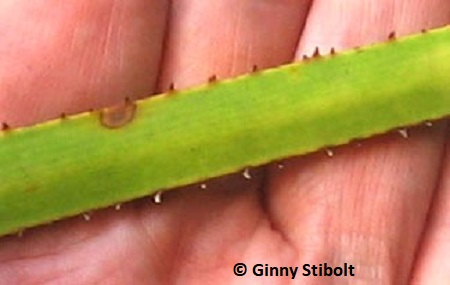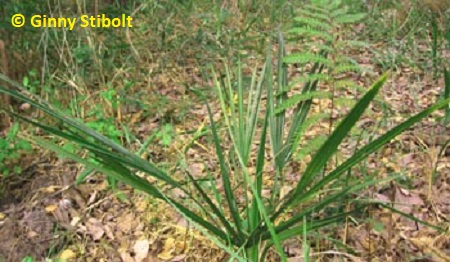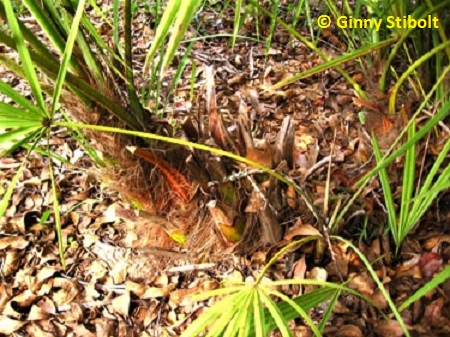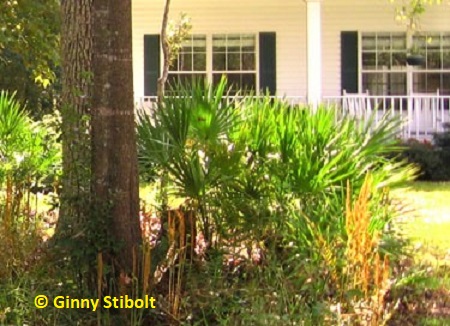Adventures of a Transplanted Gardener |
|||
Palmettos in the landscape
| |||
 |
<< The hard, recurved teeth on the stems (petioles) of the fronds give the saw palmetto its common name. When trimming away the old fronds, we wear leather work gloves and are careful where we walk because those teeth can gouge your skin. Palmettos make an excellent impenetrable border.
Despite their low survival rate when transplanted from the wild, palmettos are difficult to get rid of if you don't want them. The roots run deep and are extensive, so digging up a palmetto stand is a lot like work. It burns readily, but burning it will not kill it. Palmettos are fire tolerant and will sprout new growth within a week or two of burning. If you are in a high fire risk neighborhood, you should remove all palmettos within thirty feet of any buildings and keep them separated into bunches elsewhere so they don't offer a continuous source of fuel. Our neighborhood is not a high-risk area, but our palmettos are away from the house.
 |
My blue-stem palmettos
A friend gave me three blue-stem palmettos (Sabal minor) a couple of years ago. They have survived and are now growing slowly--oh so slowly. I've planted two of them near the front pond and the third is in a low spot near some sweetbay magnolias (Magnolia virginiana), but it will be a long time before they will make a "statement" in the landscape. Patience.
Palmettos are true palms, not like the sagos (Cycas revoluta), which are cycads and not palms, no matter what people call them.
Palm background
The blue stem palmetto is more closely related to the cabbage palm (Sabal palmetto), our state tree, than the saw palmetto, which belongs to a different genus. The scientific species name of the cabbage palm, "palmetto" confuses the issue of palm vs. palmetto. Generally, a palmetto is a shrubby plant. The trunk of a mature palmetto isn't usually vertical for more than few feet. The fibrous trunk grows either underground or it lies on top of the soil. While palms are not true trees, they do eventually develop vertical trunks. For the first five to ten years, a palm will look much like a palmetto while it develops a trunk. Once the trunk is established, the palm will grow vertically, but the girth of its trunk does not usually increase.
 |
Palms and palmettos are monocots and do not produce wood like true trees, which produce new layers of wood each year--their annual rings. Palm trunks are more like a grass with bundles of woody tissue throughout. This means that palms do not have bark and cannot heal wounds like true trees. It's unfortunate that many palms in Florida are located in the middle of lawns and are injured at each mowing by lawnmowers and string trimmers. The gouges in the trunk will not heal and become entry points for insects and fungi. These wounds also weaken the trunk, so while palms usually survive hurricanes, injured palms may break off at the soil line. To save your palms, replace about 18 inches of lawn around the trunks with mulch, but don't pile it against the trunks. This also makes it easier to mow.
Also, since there is no wood, the roots will never expand in girth, so they don't disrupt sidewalks, roads or foundations like woody tree roots do.
After a cabbage palm seed sprouts, the plant will remain in its palmetto stage while it develops its girth. Only when the trunk is wide enough will the palm begin to grow vertically. This may take ten years or more depending upon conditions.
When cabbage palms are transplanted from the wild, they will generate a whole new root system. Hundreds of unbranched roots grow directly from the bottom of the trunk and only after the new roots have been generated will there be any growth of the fronds. This is why almost all of the fronds are trimmed off when they are prepared for planting and they are often staked for a few months to keep them upright. At no other time should green fronds be trimmed from a palm. Almost all of the cabbage palms used for landscape plantings are transplants from the wild because they take so long to get started.
There are two major classifications of palms and palmettos based on leaf (frond) shape: the fan palms and the feather palms. Our palmettos and the cabbage palms are fan palms where the stem (petiole) is bare and the frond is palmate or arranged so that each section of the frond is arranged like spokes in a wheel. A feather palm has pinnate fronds with the sections arranged along a center stem like (guess what?) a feather.
Using Palms
Over the years, palms and palmettos have been employed in many ways:
· The Seminoles used palm fronds in building their chickees
and today thatched roofs made of palm fronds are still used as tropical
shelters for restaurants, resorts, and campgrounds.
· Seminoles and others have used the palm fronds for weaving
baskets and hats. The fronds also are a source for long, strong
fibers that are used for rope and for other weaving.
· Herbalists have used saw palmetto berries for prostate problems,
but studies have not shown this to be more effective than a placebo.
(Our berries are used only by wildlife.)
· Florida's DOT encourages palm plantings along highways
and in median strips for shade and traffic calming. Palms break
up the long view and are thought to slow drivers down. Since they
will not branch out, good visibility is preserved. Roots of palms
don't increase in girth, so road and sidewalk surfaces last longer.
· Palm trunks were used in construction and you can see palms
used as columns in a few of the older buildings at Flagler College in
St. Augustine.
· Palm hearts are eaten and the cabbage palm got its common
name because people thought the heart tasted like cabbage. Occasionally
you can find whole palm hearts for sale, but mostly they are chopped
up and canned. Since the heart is the only growing portion of
a single-trunked palm, you kill the whole plant when the heart is removed. And
as stated, our native cabbage palms take a long time to grow, so when
a palm is harvested for its heart, it may have been 50 to 100 years
old. Most commercial hearts of palm are from the fast-growing, multi-stemmed
peach palms (Bactris gasipaes) which is native to Central and
South America.
· Each spring thousands of palms are trimmed to satisfy the
market for fronds on Palm Sunday.
One of these days I'd like to plant a few cabbage palms on our lot, but until then I'll continue to enjoy our palmettos.
(Update: We never planted palms on our property, but we have a number of them in their palmetto stage that have been planted by the birds. You can tell they are palms and not palmettos by the shape of the fronds and their attachment points to their stem. Also, the blue-stem palmetto is now more than ten feet tall and has fronds that are five feet across.)
Resources:
· Bulletin with guidelines for landscapers on transplanting
palms: http://edis.ifas.ufl.edu/EP001
· I first learned about chickees when I read "Light a Distant
Fire" by Lucia
St. Clair Robson.
Ginny Stibolt is a life-long gardener, a botanist, a naturalist, and a garden writer. You may contact her or read more of her articles posted on her website: www.greengardeningmatters.com.
Copyright Ginny Stibolt


